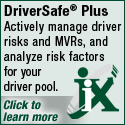
| Tuesday, February 21, 2012 | Archives | Advertise | Online Buyer's Guide | FLEETSolutions |
U.S. Legislative Updates
 U.S. DOT Issues New Distracted Driving Guidelines For In-vehicle Technologies NHTSA and the DOT proposed on February 16 new guidelines designed to encourage automakers to limit the risk of driver distraction when using communications, navigation, and entertainment technologies built into vehicles. Issued by NHTSA, the guidelines would establish specific recommended criteria for electronic devices installed in vehicles at the time they are manufactured that require visual or manual operation by drivers. Geared toward light vehicles (cars, SUVs, pickup trucks, minivans, and other vehicles rated at not more than 10,000 pounds gross vehicle weight), the guidelines proposed are the first in a series of guidance documents NHTSA plans to issue to address sources of distraction that require use of the hands and/or diversion of the eyes from the primary task of driving. In particular, the Phase I proposed guidelines recommend criteria that manufacturers can use to ensure the systems or devices they provide in their vehicles are less likely to distract the driver with tasks not directly relevant to safely operating the vehicle, or cause undue distraction by engaging the driver's eyes or hands for more than a very limited duration while driving. Electronic warning system functions such as forward-collision or lane departure alerts would not be subject to the proposed guidelines, since they are intended to warn a driver of a potential crash and are not considered distracting devices. The proposed Phase I distraction guidelines include recommendations to:
The Phase I guidelines were published in the Federal Register and members of the public will have the opportunity to comment on the proposal for sixty days. Final guidelines will be issued after the agency reviews and analyzes and responds to public input. NHTSA will also hold public hearings on the proposed guidelines to solicit public comment. The hearings will take place in March and will be held in Los Angeles, Chicago, and Washington D.C. White House Proposes Tax Credits for Vehicles The President’s budget proposal for fiscal year 2013 includes tax incentives for the purchase of advanced technology and dedicated alternative-fueled vehicles. The proposal for advanced technology vehicles replaces the credit for plug-in electric drive motor vehicles with a credit for advanced technology vehicles. The credit would be limited to vehicles that weigh no more than 14,000 pounds and be capped at $10,000 ($7,500 for vehicles with an MSRP above $45,000). The credit would be allowed to the person that sold the vehicle to the person placing the vehicle in service (or, at the election of the seller, to the person financing the sale), but only if the amount of the credit is disclosed to the purchaser. The dedicated alternative fueled vehicle proposal would allow a tax credit for dedicated alternative-fuel vehicles weighing more than 14,000 pounds. The credit would be equal to 50 percent of the incremental cost of such vehicles compared to the cost of a comparable diesel or gasoline vehicle. The credit would be limited to $25,000 for vehicles weighing up to 26,000 pounds and $40,000 for vehicles weighing more than 26,000 pounds. The credit would be allowed to the person placing the vehicle in service or, in the case of a vehicle placed in service by a tax-exempt or governmental entity, to the person that sold the vehicle to such entity (or, at the election of the seller, to the person financing the sale), but only if the amount of the credit is disclosed to the purchaser. Trucking Industry Files Suit over HOS Rules The American Trucking Associations (ATA) is suing to overturn the new hours of service rule. ATA is asking the U.S. Circuit Court of Appeals for the District of Columbia to set aside the Federal Motor Carrier Safety Administration rule as arbitrary and capricious. The hours of service rule, released in late December, reduces total driver hours to seventy from eighty-two per week and requires a 34-hour rest period before drivers start a new workweek. FMCSA to Delay EOBR Rule The Federal Motor Carrier Safety Administration (FMCSA) will not issue a final regulation this year mandating electronic onboard recorders (EOBRs) for interstate fleets. The agency is expected to issue a second notice of proposed rulemaking later this year or early 2013. FMCSA originally issued a final rule in 2010 for truck fleets with serious hours-of-service violations and a separate proposed rule for almost all interstate truck fleets in January 2011. The first rule for fleets with serious hours of service violations was struck down by a U.S. Federal Court, which ruled that FMCSA failed to ensure that devices would not be used to harass drivers. FMCSA will now consolidate the two rules into a mandate for use of EOBRs. |
 |
NAFA Fleet Management Association 125 Village Blvd., Suite 200 Princeton, NJ 08540 Telephone: 609.720.0882 Fax: 609.452.8004 |








